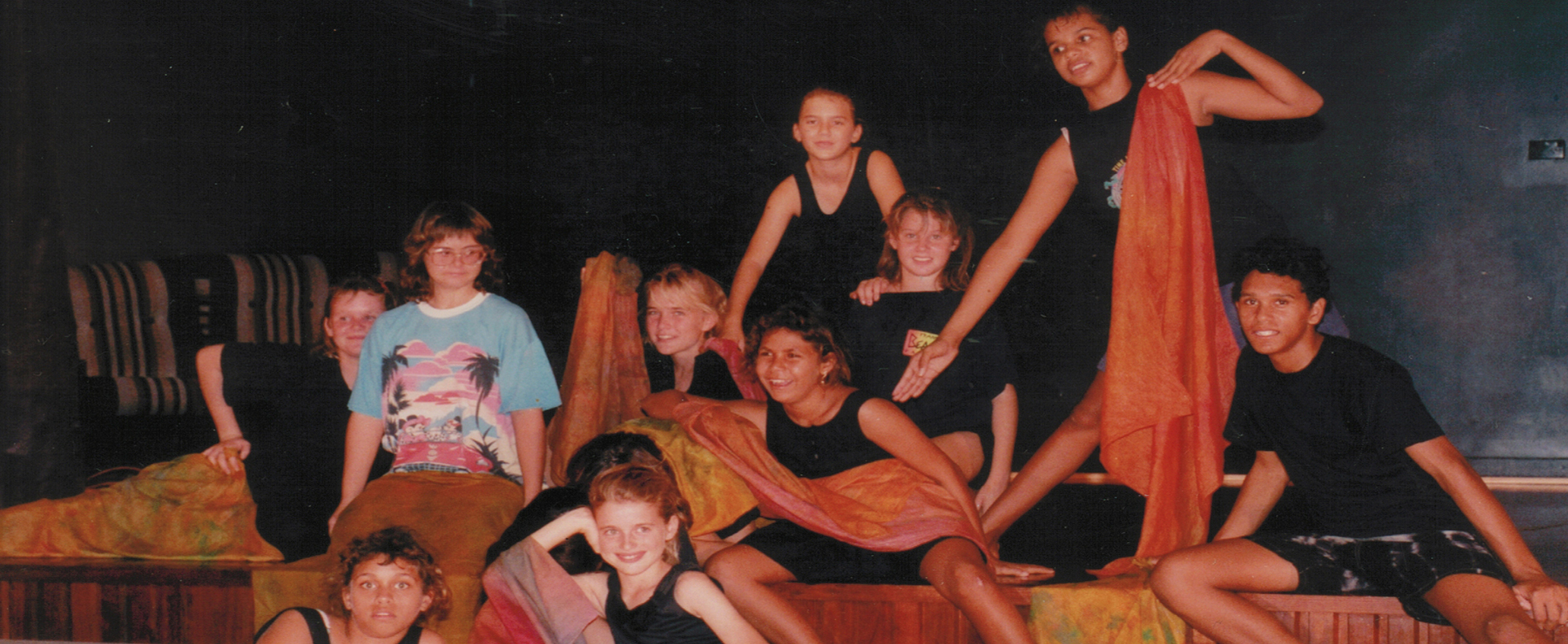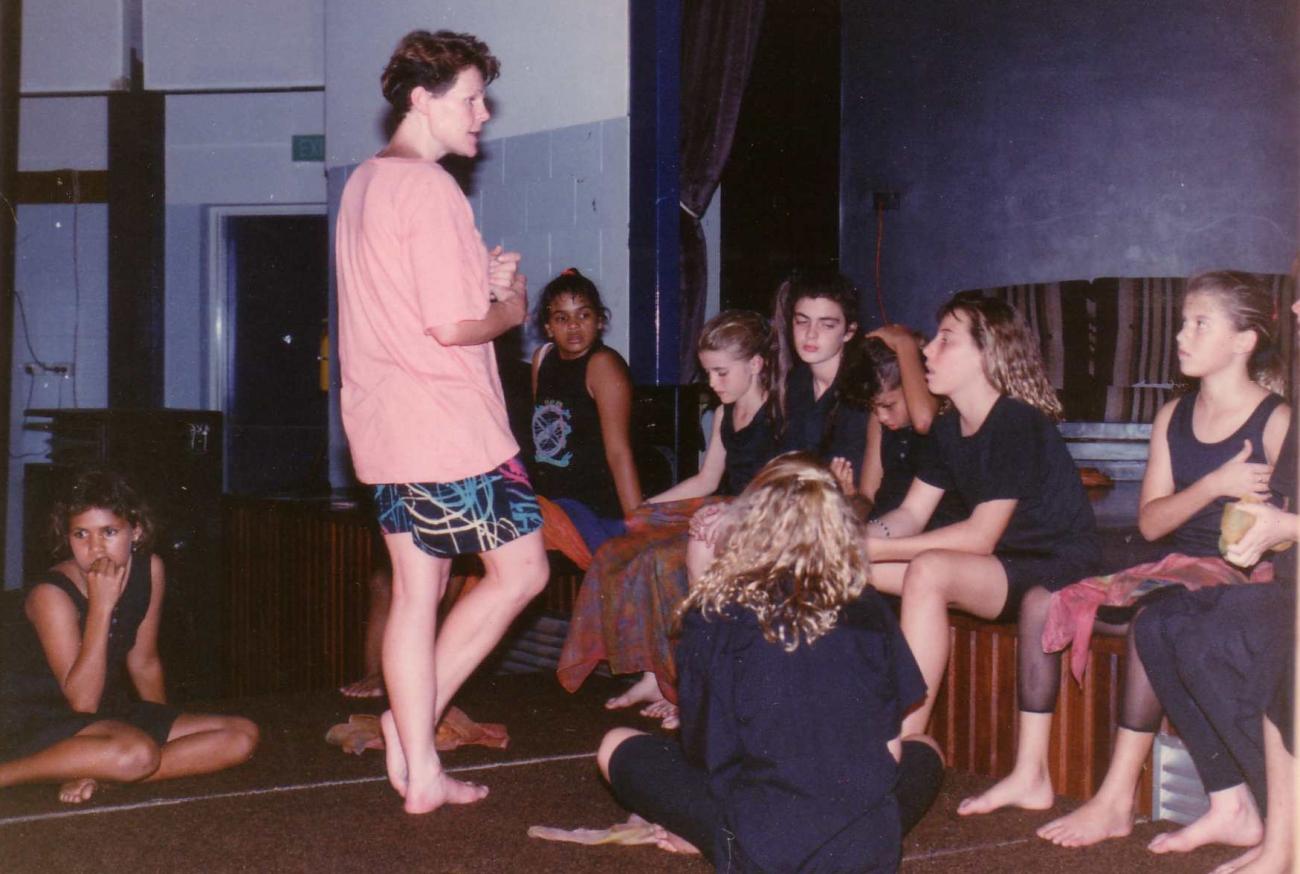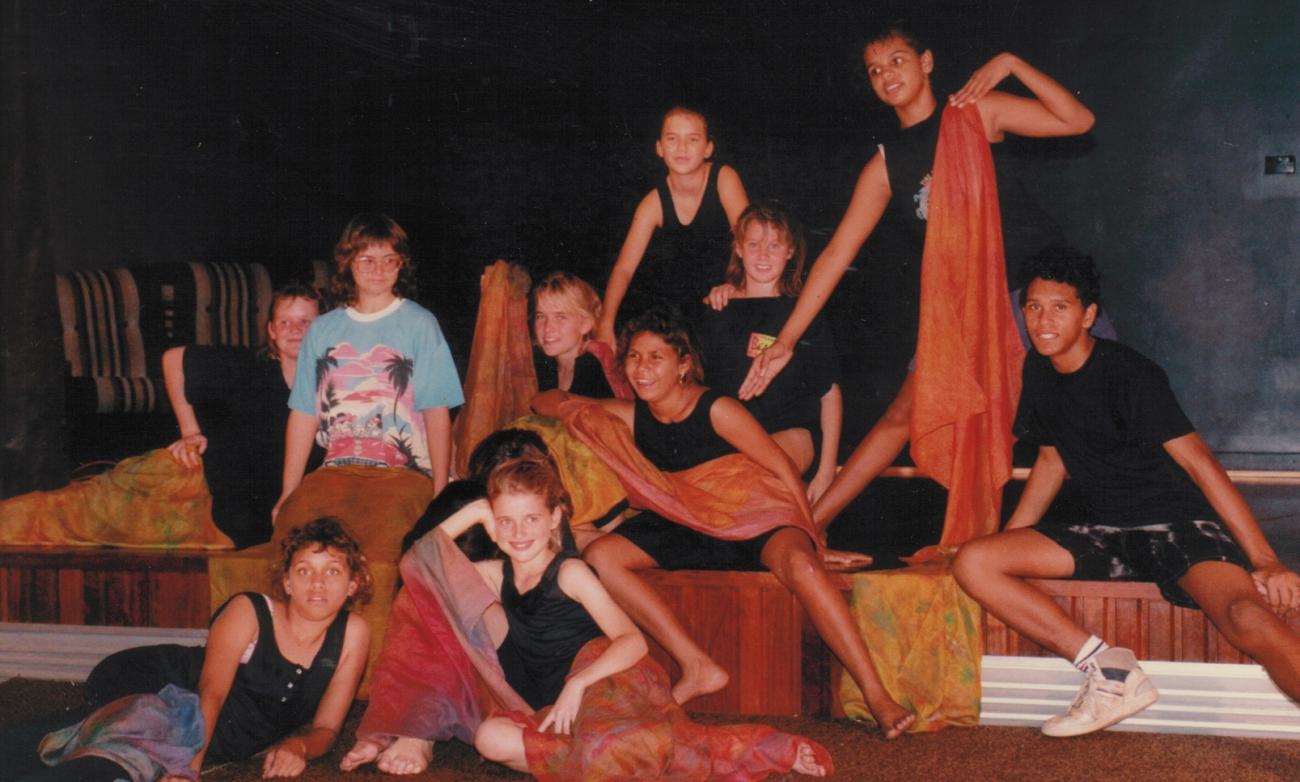Jabiru Community Residency
Text
Jabiru – Kakadu National Park and Gunbalunya Oenpelli Community.
September, 1990
Guest artist Debra Batton (from Melbourne) took part in a six-month community residency in Darwin with the Brown’s Mart Dance Program and directed the Thru Moves project. In addition Debra directed this residency.
Director's Notes - Deb Batton
Although a little daunted at spending seven weeks in a mining town, I was interested in this dance project as it was flexible and new. I enjoyed the opportunity to spend three days in the Aboriginal community of Oenpelli, giving dance classes in the school, which were greatly appreciated by that isolated community.
In Jabiru classes were given to 75 participants over 6 different classes: 3 year olds, 4 - 7’s, 7 - 11’s, teenagers, adults, acrobatics.
All classes were attended by a regular group with a few participants joining in for one-off sessions. Most participants paid a ‘term fee’ ensuring the regularity of a core group in all classes. Some paid on a weekly basis to encourage tentative participants and some of the teenagers not supported by their parents.
During the first week some classes were run in the school. This allowed students to try out a dance class without commitment. These were very successful, promoting the dance project and we gained new participants in the after school dance program.
The acrobatic classes were instigated after I discovered the Gymnastics equipment available at the school. Many people expressed an interest in this option. Gymnastics had been an after school activity until the teacher moved away and the activity ceased.
The majority of participants were female, except in the acrobatics, which were 50/50. In the teenagers’ groups one male Aboriginal participant showed delightful natural talent. We also integrated Jackie (a 15 year old Downs Syndrome student) who participated in the classes and performance with ease.
Venue:
The Drop In Centre was the venue for most of the dance classes except for one adult class that was held in the school. The Drop In Centre was adequate but not particularly comfortable or helpful. It did have air-conditioning and a wooden floor, but was too small with pool tables, internal walls and metal strips on the floor, all of which decreased the dance space. It was also very dark. Despite these drawbacks, it was all that was available. (The community hall had a concrete floor and was too expensive, although more spacious.) The acrobatics classes were conducted in the school in an open area – a concrete floor, but plenty of space and with the school’s help we did not have to hire it.
Performances:
The teenagers performed two dances in conjunction with the school play, which took the format of a theatre restaurant. This worked well; the two styles of melodrama and contemporary dance are not a combination I would have chosen for aesthetic compatibility. They supported each other on a practical level, sharing the venue and publicity and an audience of approximately 100 people over two nights. The event was held in the community hall with a very small stage. The area was increased with portable staging from the sports club. The portable stage was still too small for a dance with 12 teenagers. It also separated when the dancers moved but was held together by willing stagehands. Despite the size of the stage and its instability, the dancers thoroughly enjoyed being up there.
The 7 - 11 year age group performed during the day at the dress rehearsal for the school with many parents in attendance. This performance was not included in the evening performance as the atmosphere was not appropriate.
The Wind Festival, held on an outdoor grass area at sunset, was a colourful event. The dancers seemed a little insecure without the more defined space of a stage. However, the two groups performed again remarkably well. Many parents expressed delight in seeing their children perform as part of this day.
As I was based in Darwin at the time and for several weeks preceding the event, opportunities to rehearse with the two groups were limited. A teacher from the school organized rehearsals to ensure the dancers were confident to perform. I made it back to Jabiru for two weekends for rehearsals and was there to support them on the day.
Support:
The Jabiru Arts Council were very supportive, especially John Carrigen (Librarian). He was very flexible and allowed timetable changes according to participants’ needs. He also welcomed me in social activities and assisted me being accepted into the community.
The school was also extremely helpful and supportive. The Principal, Kay Aldenhonen (Also Arts Council) was wiling to assist in anything from administrative to practical tasks such as providing room and announcements. The secretarial staff contributed in various ways including making certificates for all participants.
The Arts Council supported my decision to have the two groups perform for the Wind Festival. Their assistance in organizing rehearsals when I was able to get out there was crucial.
The school and council were also supportive of bringing the Jabiru dancers to Darwin to perform in Thru Moves. However, the practicalities of this became too difficult without enough parental support (particularly the teenagers’ group) for who I thought the experience would be most beneficial.
Oenpelli:
I was invited to give dance workshops to children and teachers from the Oenpelli School. I held a workshop in the classroom with ten girls aged 6 - 16. Three teachers also participated and encouraged the students to move away from the walls.
It was a difficult session, my first experience of the very self-conscious, “shame” attitude of Aboriginal people. The age range was difficult, as I had to provide a suitable dance experience for all participants in one session, this proved very challenging. By the end of the hour the participants danced but I was unsure as to how positive the experience was. However the teacher expressed enthusiasm and arranged for my return.
The second visit was held as part of the school day. I conducted sessions for each grade (levels 0 - 6) with 45 minutes each. The pre-schoolers started the day, the secondary girls finished. This full day was very tiring, but much more successful, due to the appropriateness of working with a group of the same age who felt comfortable with each other.
The third day was a repeat of the second and more successful again as the children were more familiar with me and I with them. It became obvious that a series of workshops where a trusting relationship between dancer/teacher and the students development could be a positive dance experience for all. The importance of being an ongoing activity rather than a series of one off activities.
I gained a great deal from the experience and would be interested in a longer residency in Oenpelli.
Artistically:
I attempted to be open with each group and meet their needs or desires in dance.
The adults’ classes tended to be a modern dance technique class with some compositional elements and a small amount of contact and improvisation. They expressed no desire to perform.
The teenagers’ classes became more compositional as it became clear that they wanted to perform. They were very enthusiastic about improvisation and we explored themes and structures and eventually used these to create a performance piece. At the same time they expressed a desire to learn a dance and this included steps which I taught and steps which they created on their chosen theme, ‘growing up’. Six weeks was not really long enough for a thorough exploration of the theme or for the ‘perfection’ of the product. This group performed three times and it was wonderful to see their confidence increase by the third performance.
Unfortunately time and resources did not allow us to create costumes although the dancers were eager to do this. The improvisation work included each dancer holding a silk scarf. These were bought by the arts council from Duluk Duluk which is an Aboriginal printing workshop in Jabiru. It was good to extend the project into the community in this small way.
The 7 - 11 year olds were also enthusiastic about performing and we worked together to create their dance. Their classes included dance exercises and creative movement. This group performed for the school (dress rehearsal) and at the Wind Festival.
The 4 - 7’s class tended to be more creative movement and movement games. Although I am sure they would have been willing to perform I decided that the process of rehearsing the same dance would have been less beneficial and enjoyable than a more creative week-by-week format.
The 3 year old's class was creative movement including some gymnastics tumbles and sing‘n’dance activities. The parents often joined in, especially in the first weeks. The class time was perhaps too long: 45 minutes is plenty for this age group.
The acrobatic group learned some partner balances, gymnastics tumbling and the ever-favorite mini-trampoline with crash mat. If more time were available it would have been good to devise a performance piece of acrobatics.
Follow up:
A follow up would be very worthwhile, especially an event that involved more groups from within the community from the outset. There are two local bands in Jabiru with whom I talked to regarding creating music for the dances. However, they did not feel confident with this idea over the limited time available. It would be exciting to develop a project with a musician and designer to work with the existing groups and to collaborate with a choreographer on a performance project. This would extend the project into the wider community, perhaps culminating in an extravaganza at the Wind Festival.
As a guest dancer in residence I enjoyed the challenge of working in a mining town that is almost in a National park with the unique qualities and difficulties that this creates. I have been affected by this opportunity to experience Aboriginal culture and the bewildering landscapes of the Northern Territory. The spiritual connection between the people and land being an area I am thirsty to know more about, and I look forward to exploring this in my future choreographic work.
Creative Personnel
Debra Iris Batton
Debra joined 'Legs On The Wall' in 1996 performing in 'All of Me' at the Edinburgh Fringe Festival. She co-devised and performed in 'Under the Influence' and 'Home Land' and during 1998 was appointed Artistic Coordinator of the Company. Debra performed in and co-devised Legs on the Wall’s first international production Flying Blind which premiered in Canada in 2001. In 2002 Debra made her directorial debut with Legs on the Wall with Runner up. In 2004 she was Legs’ Director on Eora Crossing (Sydney Festival) and co-directed Back in your Box, a co-production for Australian Theater for Young People. Prior to 1996 she performed as an acrobat, aerialist, tumbler and clown with Circus Oz for three years, touring South America, USA and Europe.
Debra studied contemporary dance at Victoria University (Rusden) and in her career as a performing artist has worked in a professional capacity as a choreographer, dancer, director, co-devisor and actor. Debra worked with Storm In A tea Cup Dance Theatre (Melbourne: Artistic Director David McMicken), Darwin Community Arts and Dance Program, Magpie Theatre and State Theatre Company of South Australia.
1990
Dance Development Office: Sarah Calver
[Under Brown’s Mart Community Arts – Executive Officer Ken Conway]
Photos
Videos
Explore Further
Jabiru
Jabiru is a mining town approximately 2.5 hours from Darwin within the Kakadu National Park. On request from the Jabiru Arts Council (John Carrigen) a holiday dance program was run in September 1989 that led to the 1990 residency.
Oenpelli
Oenpelli is an Aboriginal settlement in Arnhem Land, a 1.5-hour drive from Jabiru and isolated by the flooding river during the wet season.



